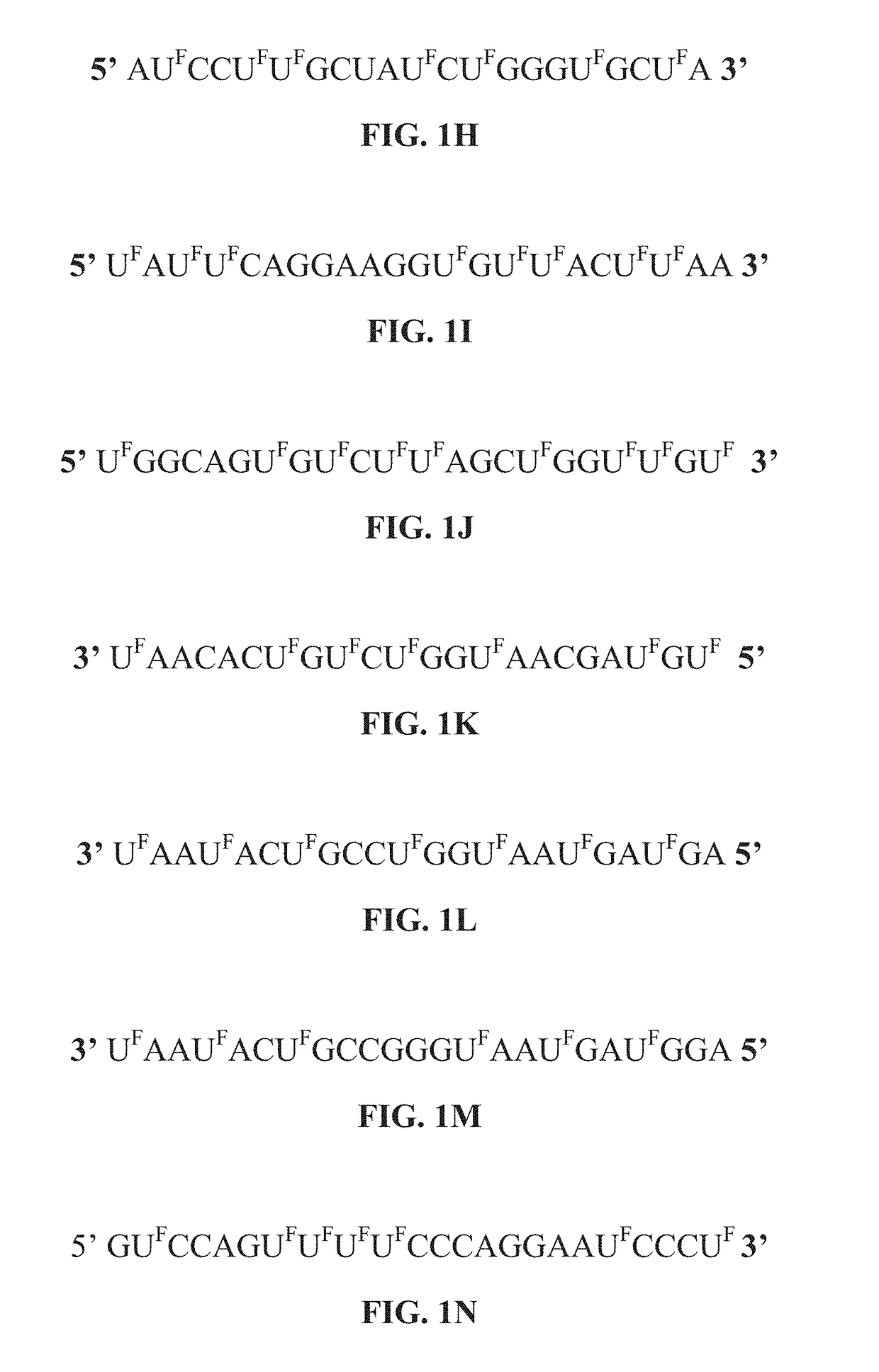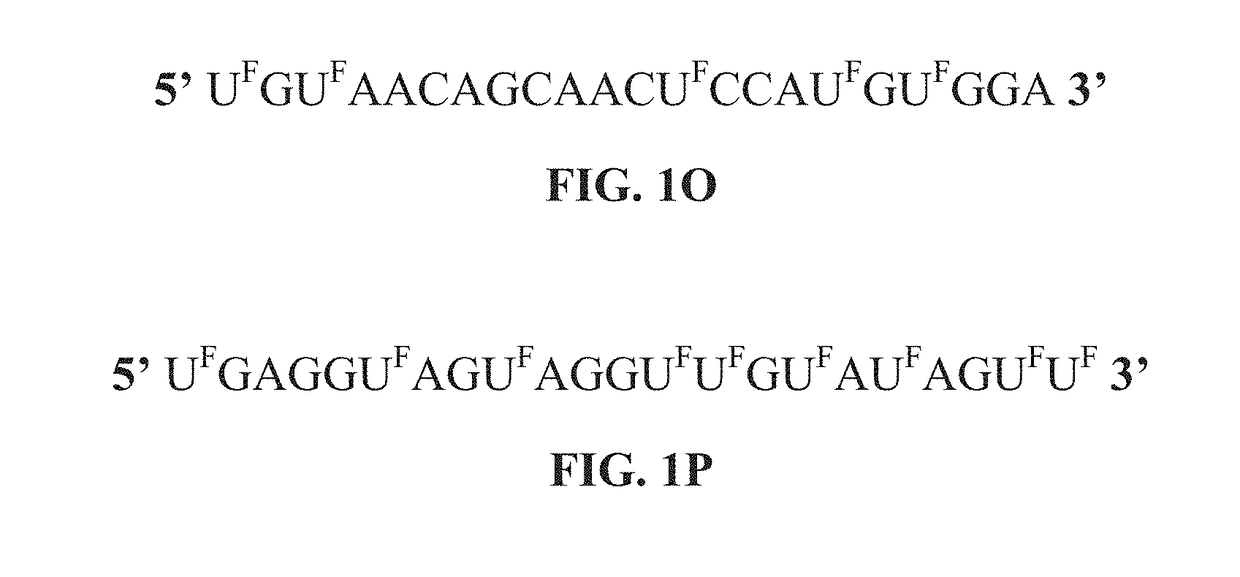5-halouracil-modified micrornas and their use in the treatment of cancer
a technology of halouracilmodified micrornas and cancer, which is applied in the field of nucleic acid compositions, can solve the problems of difficult cure, difficult treatment, and ineffective non-invasive treatment of pancreatic cancer, and achieves the effects of reducing side effects, improving efficacy, and reducing toxicity
- Summary
- Abstract
- Description
- Claims
- Application Information
AI Technical Summary
Benefits of technology
Problems solved by technology
Method used
Image
Examples
example 1
and Methods
[0273]Modified microRNAs:
[0274]the 5-FU modified miRs were synthesized by an automated oligonucleotide synthesis process and purified by HPLC. The two strands were annealed to make the mature modified 5-FU-miRs of the present disclosure. More specifically, a process referred to as “2′-ACE RNA synthesis” was used. The 2′-ACE RNA synthesis is based on a protecting group scheme in which a silylether is employed to protect the 5′-hydroxyl group in combination with an acid-labile orthoester protecting group on the 2′-hydroxy (2′-ACE). This combination of protecting groups is then used with standard phosphoramidite solid-phase synthesis technology. See, for example, S. A. Scaringe, F. E. Wincott, and M. H. Caruthers, J. Am. Chem. Soc., 120 (45), 11820-11821 (1998); International PCT Application WO / 1996 / 041809; M. D. Matteucci, M. H. Caruthers, J. Am. Chem. Soc., 103, 3185-3191 (1981); S. L. Beaucage, M. H. Caruthers, Tetrahedron Lett. 22, 1859-1862 (1981), the entire contents o...
example 2
microRNAs of the Present Disclosure have Anti-Cancer Activity
[0304]As shown in FIGS. 3, 8B, 12A-D 13A-B, 14A-E and 15A-C, the modified miRNAs (modified miR: 129, 15a, 192 (215), 140, 502, 34, 194, 200a, 200b, 200c, 145, let-7 and 506) are effective in inhibiting colon cancer, blood cancer, breast cancer, gastric cancer, pancreatic cancer, and lung cancer cell proliferation when compared to one or controls (i.e, non-specific microRNA, non-modified miRNA precursor, or vehicle alone). In addition, the modified miRNAs can be delivered into cancer cells without the transfection reagent (as shown in FIGS. 17A-17B). Notably, the results show that cancer cell proliferation across several different colorectal cancer cell lines, pancreatic cancer cell lines, breast cancer cell lines, lung cancer cell lines, a gastric cancer cell line and a leukemia cell line is inhibited significantly when compared to cancer cells treated with control microRNAs or vehicle alone.
example 3
miR-129 Nucleic Acids have Anti-Cancer Activity
[0305]In the following experiments, 5-FU was incorporated into miR-129. In one experiment, all U bases in miR-129 were replaced with 5-FU, as shown in the structure provided in FIG. 1A, where “UF” represents 5-fluorouracil or other 5-halouracil. In another experiment, all U bases, except the seed region of the miR-129, were replaced with 5-FU, as shown in the structure provided in FIG. 1B.
[0306]Analysis of Target Specificity:
[0307]The results of Western immunoblot experiments in colon cancer HCT-116 cells demonstrate that the exemplary modified miR-129 polynucleotides of the present disclosure were able to retain their target specificity to TS, BCL2 and E2F3 via. The results are shown in FIGS. 2A and 2B, which shows the results for the modified miR-129 nucleic acid having all U bases were replaced with 5-FU, as obtained by two separate operators as set forth in SEQ ID. NO: 4. Of further significance, the exemplary miR-129 mimics were fo...
PUM
 Login to View More
Login to View More Abstract
Description
Claims
Application Information
 Login to View More
Login to View More - R&D
- Intellectual Property
- Life Sciences
- Materials
- Tech Scout
- Unparalleled Data Quality
- Higher Quality Content
- 60% Fewer Hallucinations
Browse by: Latest US Patents, China's latest patents, Technical Efficacy Thesaurus, Application Domain, Technology Topic, Popular Technical Reports.
© 2025 PatSnap. All rights reserved.Legal|Privacy policy|Modern Slavery Act Transparency Statement|Sitemap|About US| Contact US: help@patsnap.com



